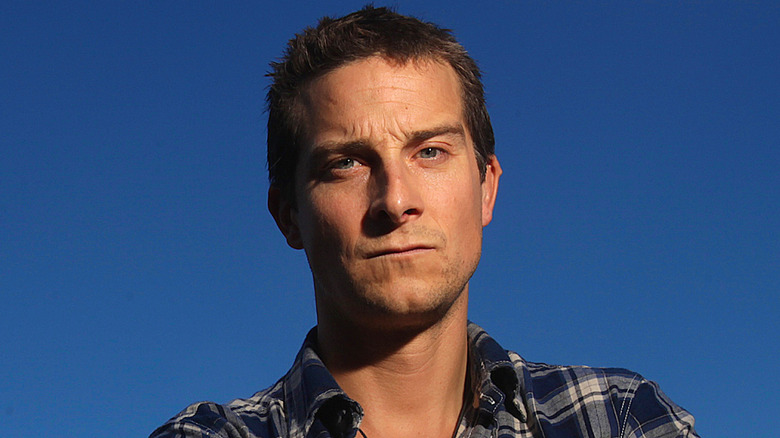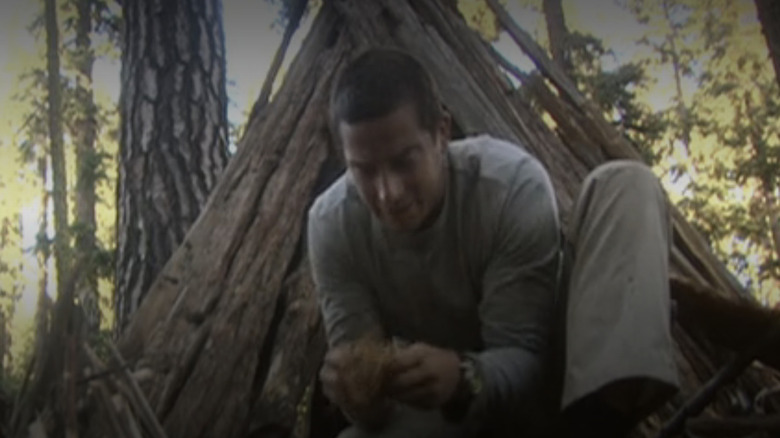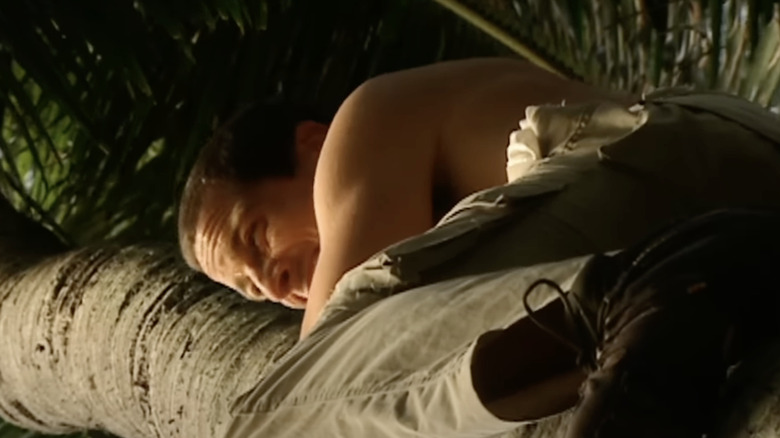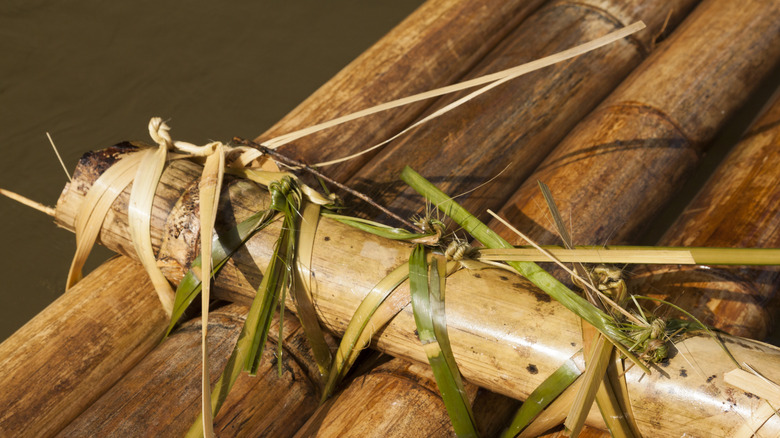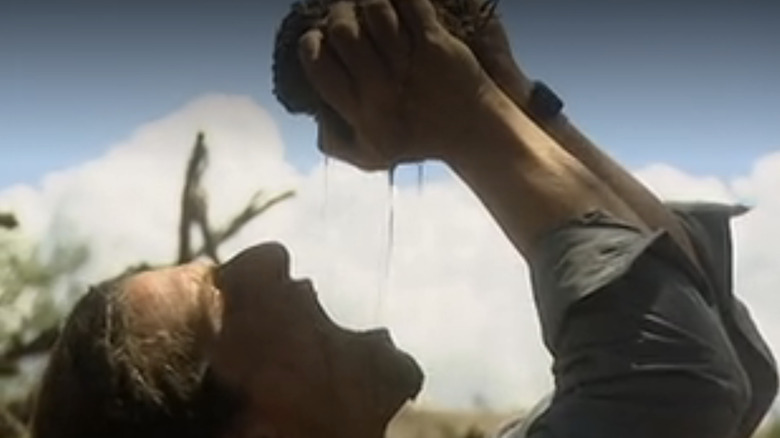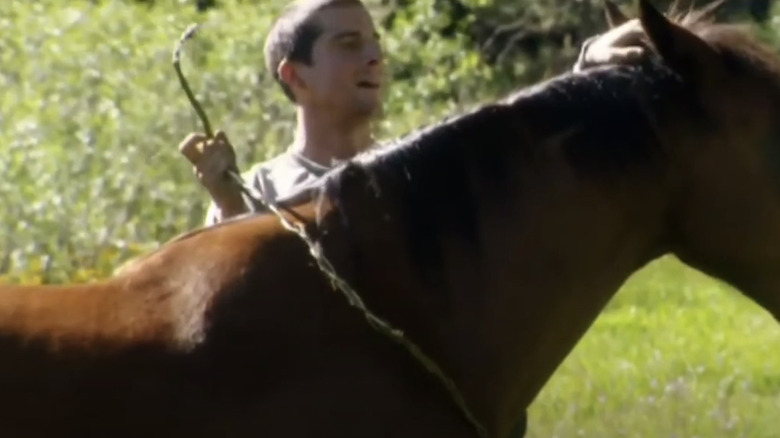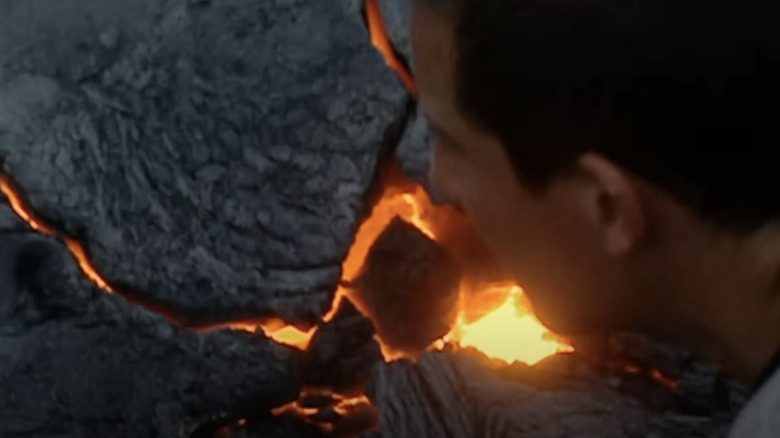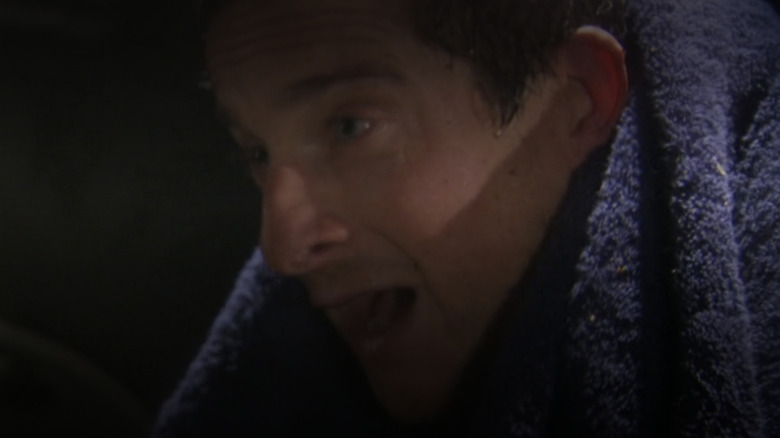Man Vs. Wild Moments That Were Totally Fake
"Man vs. Wild" caused a sensation when it ran on the Discovery Channel in the mid-2000s. Each episode began with host and star Bear Grylls attesting to the authenticity of the show, explaining that, while a production crew followed him around the wilderness, they didn't aid or assist him in any way. An experienced survivalist and crafty outdoorsman, Grylls said he brought a knife, a flint, and water to the wilds, and that was basically it, relying on his wits for most of his basic needs. Each episode of "Man vs. Wild" – known as "Born Survivor" in some markets, including Grylls' native U.K. – was thus presented as a brutally unflinching account, or instructional film, on how to brave various terrains. It made Grylls a star, and his name became synonymous with "survival."
It all makes for compelling and dramatic TV, but what if some of Grylls' filmed actions are just that — good television? Not only did Bear Grylls sometimes deliver the worst advice and perpetuate survival myths that could actually get you killed, but a number of his most astounding acts captured on camera were very much staged. Here are all the times when Bear Grylls wasn't really roughing it on "Man vs. Wild."
Bear Grylls wasn't stalked by a real bear
In "The Rockies," the very first episode broadcast of "Man vs. Wild," Bear Grylls is left to fend for himself in the Rocky Mountains near the U.S.-Canadian border and aims to return to civilization somehow. This pilot episode had to let viewers know what they were getting into with the new series, and it features some of Grylls' most daring stunts ever, including a 70-foot dive into water, negotiating a steep cliff, and avoiding a lurking grizzly bear.
Thanks to some careful editing, viewers never actually see that fearsome, dangerous animal and survival TV show host namesake. After establishing a camp in an area known to harbor grizzly bears, a scared Grylls records a bit on a handheld camera. "There's definitely something out here. I just heard a really heavy footstep out there, and I don't know," he says (via The Daily Mail). After that entity walks right up to the shelter and then away again, Grylls dares to venture outside and manages to capture footage of a shadowy figure moving into the night.
Grylls thought he almost faced a bear, and so did viewers, except that what he was actually harassed by was a "Man vs. Wild" crew member in a bear costume. A representative of the Discovery Channel claimed that the sequence was created "as a prank" on Grylls.
Bear Grylls didn't camp out in the mountains
The Season 1 "Man vs. Wild" episode "Sierra Nevada" involved Bear Grylls literally plopped into the middle of the Sierra Nevadas, the largest and arguably most rugged and treacherous mountain range in the whole of California. After his parachute descent lands Grylls right in the middle of a lake, he immediately acts to stave off hypothermia, which could particularly be a problem come nightfall, when the temperature drops precipitously. Grylls successfully builds a shelter and doesn't freeze to death, but that doesn't have much to do with the host's know-how. The survivalist's wilderness jaunt wasn't quite as remote as "Man vs. WIld" suggested. During many of the nights he was supposedly sleeping in the woods while barely protected, he was actually luxuriating at the Pines Resort at Bass Lake, a rustic resort marketed as a family destination. Grylls essentially slept in a hotel room when he was supposed to be sleeping on the cold, hard ground and enjoyed amenities like internet access and a full breakfast — so he was probably full on pancakes when he was depicted chomping off the head of a snake for morning sustenance.
He didn't rough it on a desert island
The Season 1 "Man vs. Wild" episode "Desert Island" presented that classic scenario of literature, TV, and movies: Bear Grylls was stranded on a remote island and had to use whatever he could find out there to survive. Indeed, Grylls compares himself to Robinson Crusoe at the outset of the episode.
In truth, the situation wasn't entirely desperate because Grylls hadn't set up to film on some uncharted cay in the middle of the Pacific Ocean, but rather a minor, unoccupied outpost that was technically part of the state of Hawaii. The episode shows Grylls building a shelter to protect himself from sun, rain, and wind, and using a spear to come up with a meager food supply. Grylls was never in real danger, however, because he didn't have to sleep on that island or exploit it for its small stores of food. Each night after taping wrapped for the day, Grylls was whisked away to motels on more inhabited and developed islands in Hawaii.
He didn't build a boat from scratch
Life got so pretend-hard for Bear Grylls on that punishing Hawaiian outpost while taping the Season 1 "Man vs. Wild" episode "Desert Island" that he decided to leave the area entirely and take his chances elsewhere by taking to the open sea. Another potentially dangerous part of that risky decision: Grylls hit the Pacific Ocean in a ramshackle raft made out of bamboo stalks and palm leaves, all of his own construction.
At least that's how it was depicted on television. While Grylls did build a boat by himself with his own two hands, he didn't do it off the top of his head. The Times of London reports that, before filming the sequence, survivalist and paid "Man vs. Wild" consultant Mark Weinert directed a team in the creation and building of that boat. Then crew then took it apart, and Grylls rebuilt it when the cameras were rolling.
Bear Grylls didn't divine water from poop
In the Season 1 "Man vs. Wild" episode "African Savannah," Bears Grylls is left in the plains of northern Kenya. Grylls seemingly heads into the wilds with almost no supplies, seeking to replicate the experience of tourists who get lost and stranded during safari-style vacations. Animals are a particular threat, Grylls says, with unlucky people killed by stampeding hordes all the time. He nearly becomes such a statistic after staring down the matriarch of an elephant herd who considers initiating a stampede, but Grylls avoids the conflict and continues on his journey. After he eschews standing river water due to the likely presence of bacteria, elephants wind up helping Grylls after all. One of reality TV's most disturbing moments comes when Grylls finds a large piece of elephant dung, holds it over his head, and squeezes all the liquid out into his waiting, thirsty mouth.
Grylls says this method of staying hydrated when water is desperately rare was learned from a ranger. This is all nonsense, according to Les Stroud, star of the rival reality show "Survivorman." In a Reddit "Ask Me Anything" session, Stroud called out the inaccuracies of "Man vs. Wild." "Many of the actual survival skills taught are bogus — it is NOT possible to squeeze drinkable water out of elephant dung," he said. "Well it is when your cameraman has soaked it with bottled water."
He didn't really train a wild horse
The Season 1 "Man vs. Wild" episode "Sierra Nevada" allowed host Bear Grylls to show off a wide variety of his intrepid survival skills. Dropped into the Sierra Nevada mountain range in California, Grylls trekked across three distinct biomes that each came with its own challenges and tasks: forest, alpine, and chaparral. In the latter, Grylls dealt with native animals, namely the untamed mustangs that famously inhabit the eastern part of the Sierra Nevadas. Even a seasoned survivalist like Grylls was awestruck when he stumbled onto four of the horses hanging out in a meadow. "I'm in luck. A chance to use an old Native American mode of transport comes my way," Grylls said (via the New York Post). "This is one of the few places in the whole of the U.S. where horses still roam wild."
That method of transportation: horseback riding, provided Grylls could convince one of the animals to let him ride it. It did, of course, but this isn't because of some well-honed horse-whispering or animal-training skill. According to survival expert and "Man vs. Wild" consultant Mark Weinert, those horses were all trucked in to the filming site, rented for the day from a nearby operation that lends out horses for riding and expeditions (via The Times of London).
Bear Grylls didn't brave a lava pit
The Season 1 "Man vs. Wild" episode "Hawaii: Mount Kilauea" raised the stakes for both what the series could show and what host and survivalist Bear Grylls could even handle. Having to go above and beyond the usual tasks of finding clean water and building shelter, this time Grylls had to navigate and get away from an active volcano, Mount Kilauea. In some truly harrowing sequences, Grylls appears to cheat death and conquer nature all at once, negotiating hot lava and toxic gas.
After an exposé revealed that some first-season moments on "Man vs. Wild" had been staged, the series' original U.K. broadcaster, Channel 4, launched an investigation into the show. The company discovered that the dangers in the volcano episode had been juiced or falsified. There wasn't enough deadly magma around, so crew members brought in hot coals to make it look more frightening and orange on screen. As for the sulfur dioxide that hung in the air, that was just vapor provided by smoke machines.
Bear Grylls didn't face a real windstorm
Following skepticism about the authenticity of the first season of "Man vs. Wild," along with an admission that certain events were staged by show consultant Mark Weinert, the jig was seemingly up for host Bear Grylls. In 2008, narrowly avoiding becoming a reality TV star who ruined their own career, he publicly half-apologized for one of the biggest scandals to ever hit the Discovery Channel, admitting some things hadn't been truthfully presented. "If people felt misled on how the first series was represented, I'm really sorry for that," Grylls said to the BBC, with producers swearing that future seasons of the show would "be 100% transparent."
Later seasons of "Man vs. Wild" continued to utilize orchestrated situations, but at least the production was upfront about it. In the Season 6 installment "Norway Edge of Survival," Grylls heads to one of the northernmost points in Scandinavia. In the absence of an actual, naturally occurring devastating wind storm, producers used multiple large wind machines to create conditions so difficult that they made the host cry on camera for the first time. "They blasted the hell out of me, and I thought I could get a shelter and fire going, but I just got beaten by this thing and was really shaken," Grylls told the Los Angeles Times. "The emotion was there because I thought, 'The reality is, if you found yourself in this situation, you're dead.'"
